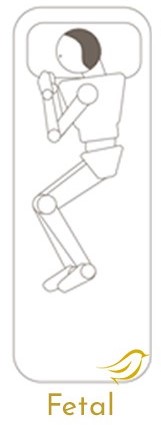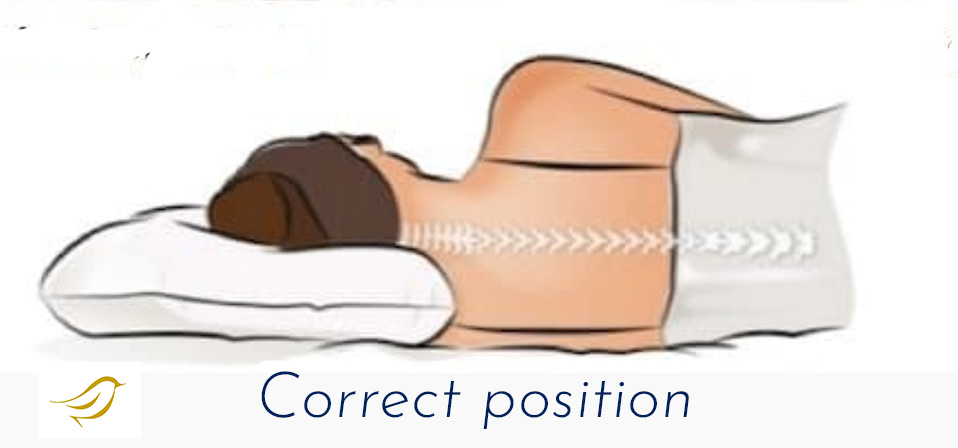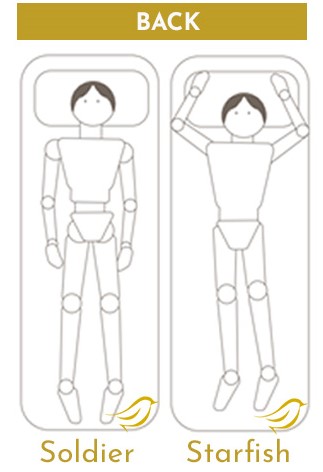What’s the Best Sleeping Position? Do you sleep on your back, side, or belly? You may have a favorite sleeping position or you may change it up now and then, for instance.
Getting your sleeping posture right can make a big difference in the way you feel when you wake up and in the quality of your daily life. A good posture is that one allow your neck being in a “neutral” position. That means your nose should line up with the center of your body.
Are you sure you are choosing the best sleeping position for your body?

Sleeping position and the impact on the health
Don’t underestimate the value of assuming a correct position inside the bed: we spend there 40% of our lives. It doesn’t exist another place where you stay for so many consecutive hours, and assuming a wrong position means seriously impacting the health of your body.
Your sleeping pose can have a major impact not only on your slumber but on your overall health. Poor sleep posture could potentially cause back and neck pain, fatigue, sleep apnea, muscle cramping, impaired circulation, headaches, heartburn, tummy troubles, and even premature wrinkles.
And that’s not all. Some researches even suggest that the wrong sleeping position may cause toxins to filter out of your brain more slowly, affecting how your brain is able to clear waste, and improving the chances of developing some neurological diseases (Stony Brook University researches).
Which is the position you like the most? Keep reading to learn how the way you sleep could be impacting your health in several ways.
Sleeping Position: there are 6 different ones
Researches identified 6 most common positions people assume during the sleep, which can be categorized in 3 main categories:

- SIDE position
- Prone position ( Sleeping on the STOMACH)
- Supine position (Sleeping on the BACK)
Generally people doesn’t maintain the same position for whole sleep, but change it frequently. It’s quiet normal that the position assumed to fall asleep is not the same you have the morning upon awakening.
But often changing position can occur so frequently to become a real disturbance of your sleep, waking you up several times during the night and impacting the quality of your rest. And this is not so normal and shouldn’t be underestimate, because it cause a loss of the quality of your life. And often the causes are hidden inside your bed.
Let’s understand what can help you in improving the quality of your sleep, analyzing each single category..
The 3 Side Positions
 The three side sleeping positions are the most popular by far: 69% of population choose one of these. As it turns out, sleeping on your side is actually pretty good for you, especially if you’re sleeping on your left side.
The three side sleeping positions are the most popular by far: 69% of population choose one of these. As it turns out, sleeping on your side is actually pretty good for you, especially if you’re sleeping on your left side.
There’s a scientific reason why these are the most popular ones. According to the National Sleep Foundation, the circulation in your body is improved when you lay on one side, with a direct impact in reducing snoring. It is also very useful when pregnant: using the left side, it prevents uterus from pressing against the liver, which is on your right side.
Moreover it seems possible that sleeping on your side could be good for your brain. Scientists recently learned that our brain clear out waste more quickly while we sleep. Whether or not the position you sleep in influences this waste removal is not officially demonstrated even if some studies suggest side-sleeping might clear brain waste more efficiently than other postures.
But pay attention: if this positions may be good for those who snore, there are some risks behind them, particularly if you have some forms of arthritis. Let’s have a deeper look.
Fetal Position
 You sleep in the Fetal Position when, laying on one side, your legs are bent and curled toward your torsos. It’s a specific option inside the category of Side Sleeper positions and it’s the most popular one, chosen by approximately 41% of adults.
You sleep in the Fetal Position when, laying on one side, your legs are bent and curled toward your torsos. It’s a specific option inside the category of Side Sleeper positions and it’s the most popular one, chosen by approximately 41% of adults.
Unfortunately, sleeping in the fetal position does have a few downsides:
- The position can restrict breathing in your diaphragm because the body is curled up too tight
- It might leave you sore in the morning, joint pain or stiffness, particularly if you suffer from arthritis
- You can wake up with neck pain, when the head is not welled supported by the pillow and the spine is not well aligned
This is the reason why hardly anyone is able to maintain this position for the whole night, particularly when there is a misalignment of the neck with the spine, that is when the head is too high or too law if compared with the shoulders.
Log & Yearner position
 28% of adults choose to sleep on one side in a position where torso and legs are relatively straight.
28% of adults choose to sleep on one side in a position where torso and legs are relatively straight.
Not only helpful to reduce snoring, it’s great for your digestion and might even reduce heartburn. This is the reason why Log and Yearner positions are really recommended for people who suffer from acid reflux. Contrary to fetal position, since your spine is elongated, it wards off back and neck pain.
Sleeping on your side, on the other hand, may not always be the best. Not only can it cause stiffness in your shoulders, it can also lead to jaw tightness on that side.
And that’s not all. Research suggests that sleeping on your side could contribute to wrinkles, because half of your face pushes against the pillow. This phenomena is much more evident when your pillow is not fitting your necessities, and you rub your face against it trying to find a more comfortable position.
Some TIPS for Side Sleepers
If you are a Side Sleeper, follow these simples tips to improve the quality of your rest:
- Straight out your body as much as you can, avoiding tucking your chin into your chest and pulling your knees up high. The best is to have torso and legs relatively straight.
- If you cannot avoid to assume fetal position, make sure your posture is relaxed when you curl up. Deeply breath 3 times after laying down on your mattress before assuming the final position.
- Pay attention to your pillow, and utilize the one that best suites the shape of your neck. When not correctly aligned to your spine, your neck is subject to high pressure and you will wake up with that nagging neck and shoulder pain that never let you go.



Stomach position or Prone position
 If you are usual to sleep on your stomach, it’s important you know this is the worst position for your health. You are one of the 7% of adults that like picking this pose. It may help ease snoring by shifting fleshy obstructions from your airway; but sleeping in this position may aggravate other medical conditions.
If you are usual to sleep on your stomach, it’s important you know this is the worst position for your health. You are one of the 7% of adults that like picking this pose. It may help ease snoring by shifting fleshy obstructions from your airway; but sleeping in this position may aggravate other medical conditions.
Do you wake up with neck pain? Are your arms tingling? Are you sore every single morning?
Stomach sleepers put pressure on their muscles and joints, a big stress every single night. Possibly leading to numbness, tingling, aches, and irritated nerves particularly your neck.
Moreover, since it’s really hard to keep your spine in a neutral position, it can lead to back pain too.
It’s best to try to choose another position. If you think it’s hard to change habits, read our TIPS. You will discover how to do it.
Some TIPS for Stomach Sleepers
Prone position is really dangerous for your spine. This is something you should keep in mind. This position stress the whole vertebral column and irritates nerves.
Often this kind of habit is associated to sleep disorders: difficulties in finding the proper position to fall asleep, frequent awakenings (more or less conscious) to change side or to move arm numb. Strange positioning of legs and knees in order “to release” from back pain.
Do you know that behind this position often stays a unappropriated pillow?
A pillow that doesn’t suite your measures can feel you discomfort when assuming side position or, even worst, the back one. And this is the reason why often people begin to sleep on their stomach, taking dangerous poses of their head, using only a portion of the uncomfortable pillow.
Therefore, before throwing the towel and accept this bad habit, try to understand if your pillow is the correct one
If sleeping on your stomach is the unique possibility for you to rest, making it as better a you can.
- Use a thin head pillow to reduce any added stress on your neck. What does it mean “thin”? It doesn’t exist a specific height that can suite to everybody. It must be defined based on anthropomorphic measurement of each specific body. The knowledge of Nightingold can help you in solving this issue.
- Positioning a second pillow under your pelvis can be useful particularly if you have back pain issues. Raising the hips relax the tension that can be felt around lower back area. But this solution should be carefully evaluated.
Back Positions or Supine Position
 Back position is considered the best one for the alignment of the spine and for heartburn, if slightly elevated with a pillow of your size. Unfortunately it’s not the most popular position; only 13% percent of people sleep on their backs.
Back position is considered the best one for the alignment of the spine and for heartburn, if slightly elevated with a pillow of your size. Unfortunately it’s not the most popular position; only 13% percent of people sleep on their backs.
By far the healthiest option for most people, sleeping on your back allows your head, neck, and spine to rest in a neutral position.
As the Cleveland Clinic explains, sleeping on your back uses gravity to keep your body in an even alignment over your spine, which can help reduce any unnecessary pressure on your back or joints. This means that there’s no extra pressure on those areas, so you’re less likely to experience pain and relieve hip and knee pain.
Sleeping facing the ceiling is also ideal for warding off acid reflux. Just be sure to use a pillow that elevates and supports your head enough. In fact your stomach should be below your esophagus to prevent food or acid from coming up your digestive tract.
But back-sleeping has its disadvantages too.
If you suffer from snoring, sleeping on your back may aggravate these conditions as well. Moreover it is not the best position if you struggle with back pain: it can make existing back pain worse, which is why it’s important to make sure you’re properly supported.
Some TIPS for Back Sleepers
If you are not suffering of specific back pain, this is the best position for you.
The focus point, for you, should only be the pillow.
An unappropriated one can transform a good position in a very dangerous one. In fact:
- The pillow can cause important misalignments between your neck and your spine. This generate points of stress that will shift into neck pain.
- If you cannot experience a sensation of comfort and well-being, your sleep will be agitated and restless, and this will have a big impact on the quality of your sleep.



Understanding if your pillow is the correct one can be not so easy, but play a key role for your health. Nightingold can help you with its knowledge and the deep process that have created to investigate your needs and design your perfect solution.
How to improve your current sleeping position
The bed, and especially the pillows, are important to prevent neck problems developing or reoccurring. More than half of reported neck problems are created by, or are worse during or after, being in bed.
Now you have more information about the impact on your health of how you sleep.
We have figure out how important is to keep a neutral position with your neck and your spine and how the pillow play a leading role in creating this alignment.
Get a pillow that allow the right height for you: too high and your neck will be bent too far forward; too low and your neck will be bent too far backward.
Probably now you can better understand why there cannot exist a unique standard pillow dimension that can feet for everybody. Each one of us has his own measures and shapes, as well as own taste, needs and habits. And you need the best for your health.
Positioning your neck at a proper height is key for the health of your body. Don’t compromise.
Choose the best pillow FOR YOU, your desires, your necessities, the way you sleep or, even better, a pillow allow you to change your bad sleeping habits.
Nightingold can help you in designing your best solution. Discover our innovative solution and the process we use to design your pillow.
For any information don’t hesitate to contact us, click our Nightingale
We are happy to put at your disposal our knowledge.
